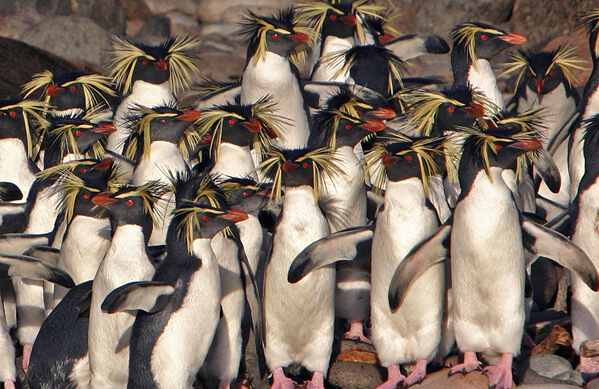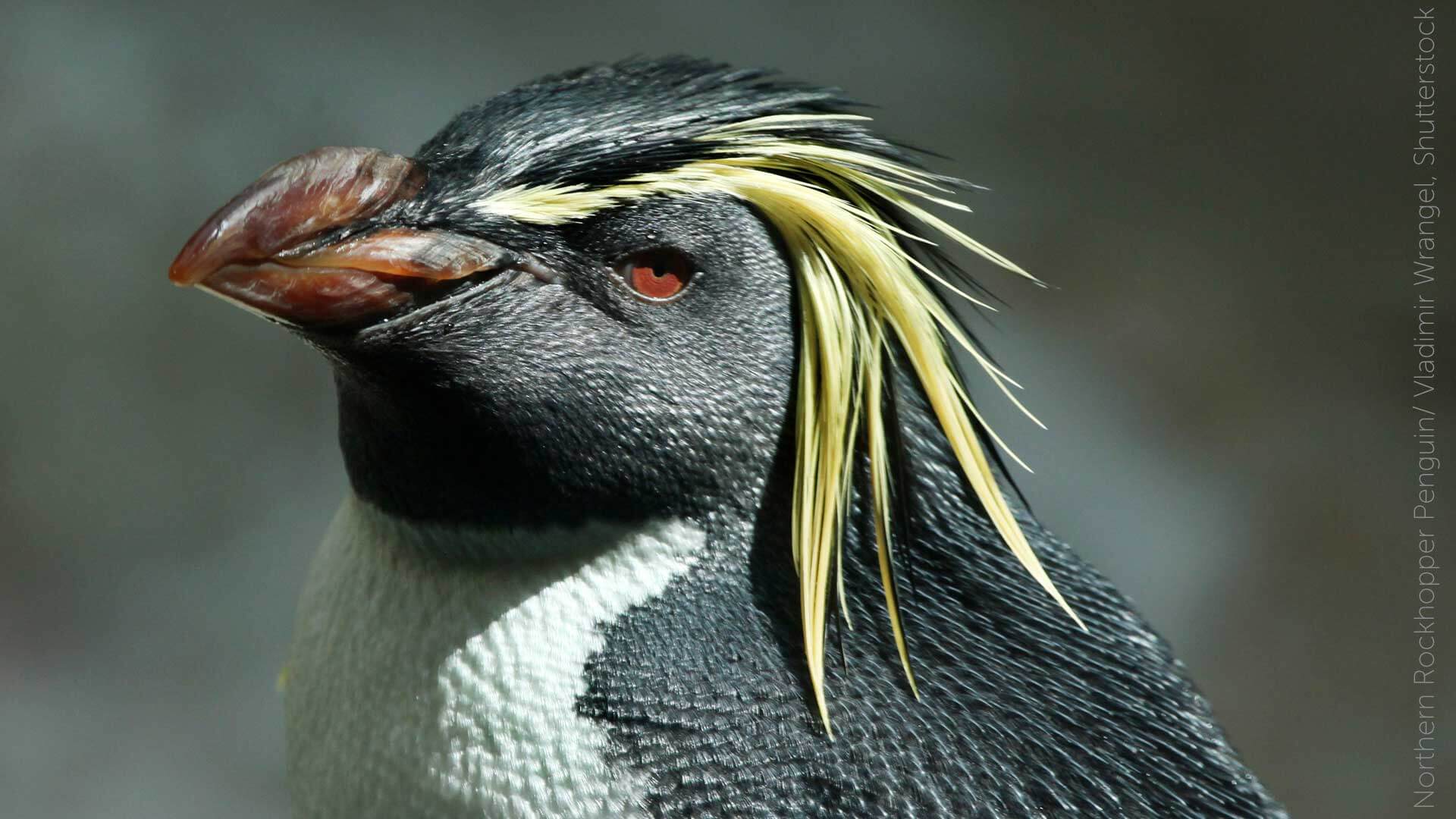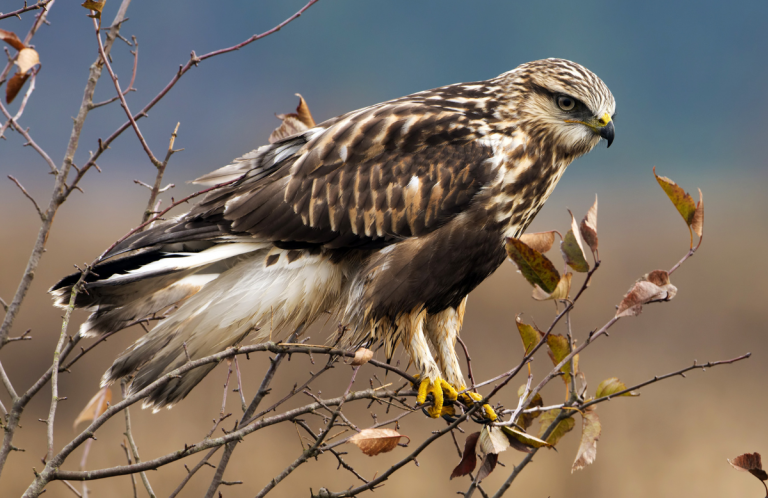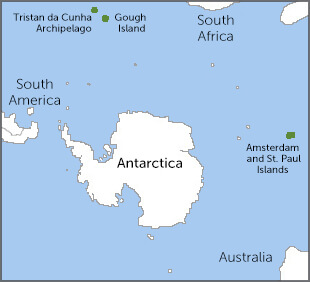 The Northern Rockhopper Penguin is one of the smallest "crested" penguins; at about five pounds, it's about half the size of the Macaroni Penguin. It's also known as Moseley's Penguin in honor of Henry Nottidge Moseley, a British naturalist who participated in the famed 19th century HMS Challenger expedition that laid the groundwork for the study of oceanography.
The Northern Rockhopper Penguin is one of the smallest "crested" penguins; at about five pounds, it's about half the size of the Macaroni Penguin. It's also known as Moseley's Penguin in honor of Henry Nottidge Moseley, a British naturalist who participated in the famed 19th century HMS Challenger expedition that laid the groundwork for the study of oceanography.
Rockhopper penguins earned their common name from their behavior on land: They can slide on their bellies as many penguins do, but to navigate the steep, rocky shores of their breeding islands, rockhoppers use their strong, thick-skinned feet and legs.
Keeping Out the Cold
Like the King Penguin and other penguin species, the Northern Rockhopper Penguin has a substantial layer of fat, sheathed in a layer of air-trapping down and topped off by another layer of overlapping, waterproof feathers. Penguins' feathers are evenly distributed over their skin rather than arranged in tracts, as they are on other birds, which forms an almost impenetrable barrier against water and wind.
Penguins also have strong eye muscles and flattened corneas, which enable them to focus clearly both above and below the water. Streamlined, torpedo-shaped bodies and powerful flippers make them effective swimmers and divers.
Research published in 2006 detailed two rockhopper penguin species, the Northern and the Southern, due to morphological, vocal, and genetic differences. The Southern Rockhopper is further divided into two subspecies: the “Southern” Rockhopper and the “Eastern” Rockhopper.
Pugnacious Penguins
Northern Rockhopper Penguins are scrappy, pugnacious birds. They slap each other with their flippers, jab with open bills, and bray loudly as they tussle for nesting sites, mating rights, and food. Bowing, head-shaking, and preening movements demonstrate their "softer" side.
With noisy calls, these penguins communicate their location to mates and chicks or deliver a warning to pushy neighbors or predators. Listen to a variety of Northern Rockhopper calls here:
(Audio of Northern Rockhopper Penguin calls by Chris Taylor, XC332460. Accessible at www.xeno-canto.org/332460)
Breeding on the Rocks
Northern Rockhopper Penguins breed in the early spring or late summer in huge colonies that may number in the hundreds of thousands, often sharing space with nesting albatrosses and cormorants. The harsh, rocky shores of their preferred breeding islands keep them fairly safe from predators.
Like Galápagos Penguins and other penguin species, mated rockhopper pairs remain together for life. They return to the same breeding site each year, with males arriving first and females following a few weeks later. Their simple ground nests are sited amid tall tussock grasses.
Sharing the Daycare
The female rockhopper usually lays two eggs, which are incubated by both parents; while one parent tends the nest, the other forages for food at sea. After about a month, one chick (rarely both) will hatch.
Parent penguins feed their chicks regurgitated fish for the first few weeks. Then, the young birds join other hatchlings in a crèche watched over by a few adults. This "daycare" strategy allows parent birds more time to gather food for chicks and is seen in all colonial penguins and other ocean-going species, such as the King Eider and Red-breasted Merganser.
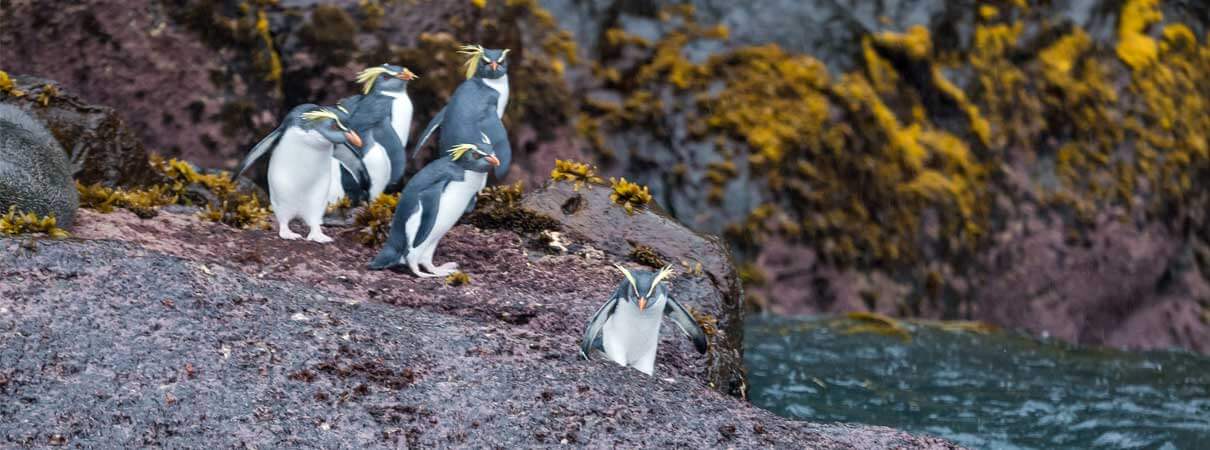
Northern Rockhopper Penguins by Charles Bergman, Shutterstock
Juvenile and adult Northern Rockhopper Penguins leave their breeding colonies in late summer or fall after molting, spending the next three to six months at sea and feeding on krill and other crustaceans, squid, and small fish. They often fish in small groups.
While foraging, Northern Rockhoppper Penguins dive as deep as 330 feet and remain underwater for several minutes at a time. They switch their foraging depth seasonally to take advantage of changes in prey, such as when squid become available.
Islands and Oil
Approximately 85 percent of the Northern Rockhopper Penguin's global population is found in the South Atlantic Ocean and breeds at the Tristan da Cunha archipelago (in the British territory of Saint Helena, Ascension, and Tristan da Cunha). The remaining 15 percent is found in the Indian Ocean on Amsterdam and St. Paul islands (French Southern and Antarctic Lands).
Oil spills are a major threat to penguins, puffins, and other diving birds, since oiled feathers lose the waterproofing necessary to keep the birds warm and dry while feeding at great depths. In 2011, an oil spill on remote Tristan da Cunha greatly affected the Northern Rockhopper: Although an estimated 3,700 oiled penguins were collected for rehabilitation, only 10 percent survived due to challenges in establishing care facilities in a timely manner.
Since this disaster, the United Kingdom's government and conservationists have worked to improve oil spill response and preparedness.
Sea Changes and Seafood
The Northern Rockhopper Penguin population has declined significantly in the last 50 years. A 2010 estimate estimated the species' overall decline to be 57 percent over 27 years.
Among the notable threats are climate change, which causes fluctuations in ocean temperature and thus availability of prey. Commercial fisheries pose dangers as well: Nets entangle and drown penguins as they forage underwater, while overharvesting of fish can cause food shortages for the birds. Marine pollution is a major threat to colonies, especially oil spills (as mentioned above) since the birds are concentrated on only a few small islands.
ABC's Seabird Program is working to address many of the threats faced by the Northern Rockhopper Penguin and other ocean-going birds such as the Laysan Albatross and Tufted Puffin.
ABC has also created a 50-50-5 Action Plan to stem bird population declines. The Northern Rockhopper Penguin is one of 50 flagship bird species identified in this plan, along with 50 priority ecosystems and five major threats.
Give now to help ABC turn this ambitious plan into action!





































